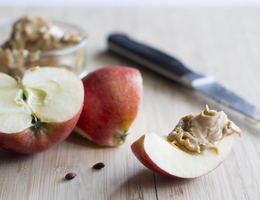
Jan. 15, 2024—According to the International Food Information Council (IFIC), 72% of Americans snack at least once a day. Those snacks add up. A recent study of more than 23,000 adults found that, on average, a single day's snacks amounted to almost 500 calories—essentially, an extra meal.
Snacking is not necessarily a bad thing. Having a small snack when you're hungry can help you avoid overeating later. And snacks can be a great way to add more fruits, vegetables, nuts, low-fat dairy and whole grains to your diet.
But choosing the wrong treats can mean consuming unhealthy amounts of sugar, salt and fat. And snacking can make it easy to take in too many calories.
Smart snacking
According to IFIC, the American Heart Association (AHA) and other experts, some simple steps can make it easier to make healthy snack choices:
Control portions. Avoid snacking out of the bag or box; it can be easy to eat too much that way. Take what you think you want to eat out of the package and place it in a bowl or on a plate. If you're still hungry, you can always serve yourself some more.
Plan your snacks. This can make it easier to make healthy choices. When you make your grocery list, include plenty of healthy snack options.
What makes a healthy treat? Try these ideas from the AHA:
- Combine fiber-rich fruit or vegetables with some protein and healthy fat. Apples with peanut butter and vegetables with hummus are two great pairings.
- Top a whole-grain cracker with lean protein, such as tuna or salmon. Low-fat cheese is another good choice.
- Eat a small handful of unsalted seeds or nuts.
- Have a glass of low-fat dairy milk or unsweetened soy or nut milk.
Store snacks strategically. To make it easier to choose healthy options, keep them accessible. Stash some snacks at work and in your car. At home, keep healthy foods at eye level in your pantry and at the front of your fridge. (Pro tip: A fruit bowl on your counter can make whole fruit a tempting option.) Meanwhile, store less-healthy options where they're harder to reach.
Think before you dig in. Taking time to check in with yourself before snacking can help you decide what you really need and make healthy choices.
Ask yourself:
Make it mindful. As you eat, take a few moments to really notice the food. How does it look and smell? What is the texture like? This exercise can help you choose your food with more intention and appreciation.
To boost your mindfulness, try not to multitask as you snack. Eating in front of a computer or TV screen can distract you from what and how much you're eating.
Explore more
Learn more about the pros and cons of snacks—and get more tips on choosing healthy, satisfying options that fit your needs.
Sources
- Academy of Nutrition and Dietetics. "5 Tips to Curb Your Late Night Snacking." https://www.eatright.org/health/wellness/healthful-habits/5-tips-to-curb-your-late-night-snacking.
- American Heart Association. "Healthy Snacking." https://www.heart.org/en/healthy-living/healthy-eating/add-color/healthy-snacking.
- Centers for Disease Control and Prevention. "Planning Meals and Snacks." https://www.cdc.gov/healthyweight/healthy_eating/meals.html.
- International Food Information Council. "2023 Food and Health Survey." https://foodinsight.org/2023-food-and-health-survey/.
- International Food Information Council. "Tips for Mindful Snacking." https://foodinsight.org/tips-for-mindful-snacking/.
- PLOS Global Public Health. "Snacks Contribute Considerably to Total Dietary Intakes Among Adults Stratified by Glycemia in the United States." https://journals.plos.org/globalpublichealth/article?id=10.1371/journal.pgph.0000802.